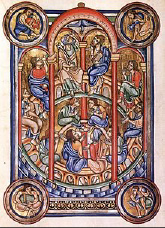Christian Pentecost celebrates the event in which the Apostles “were all together in one place: And suddenly there came a sound from heaven, as of a mighty wind coming, and it filled the whole house where they were sitting. And there appeared to them parted tongues as it were of fire, and it sat upon every one of them: And they were all filled with the Holy Ghost…” (Acts 2:1-4).
Until the 12th century the images of Pentecost presented only the Apostles as gathered in the one room.
Beginning in the 12th century Pentecost images more and more frequently put the Virgin Mary in the centre of the image among the Apostles. Often St. Peter will be on her right and St. John on her left. Her inclusion imitates the pattern set by almost all Ascension images from at least the 6th century. Mary is not mentioned in scriptural accounts of the Ascension, but medieval commentators explained she was there as a type of the Church.
By the end of the Middle Ages her presence is just about mandatory, especially with the development of the Rosary prayer.
The inclusion of Mary transforms the “meeting room” from a ‘man cave’ to a symbol of a true Christian community – that is, gathered around the feminine! As we continue to gather in the process of Synod gatherings, a suggestion I offer is that a statue, or symbol of Mary – of the feminine be centre place.
An image captured in all Christian iconography of Pentecost I have found includes the tongues of fire, one settled on the head of each person present. A close inspection of such iconography shows the flame very near to the top of the head – close enough to get burnt! Also, fire to keep alive needs fuel. Which offers the question, am I prepared to be burnt by the fire of God? Also, what fuel am I prepared to give up enabling the fire of Pentecost to continue to burn?
Artists rarely try to suggest the “mighty wind.” An exception is an illumination in the Berthold Sacramentary (13th century), where allegorical figures at the four corners pour winds from large jars. The Berthold Sacramentary is an illuminated manuscript that was produced in Weingarten Abbey in the first quarter of the 13th century. Weingarten is a Benedictine monastery. Today it is in the Morgan Library in New York.
The second image is a Champleve enamel plaque from the mid-12thC which depicts only the apostles present. The plaque is housed at The Cloisters, New York, NY.

